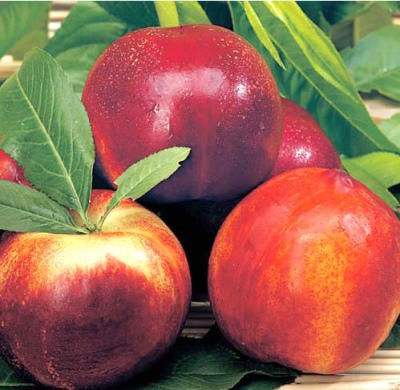
- Authors: Anderson F. W., USA
- Name synonyms: Stark red gold, Stark red gold nectarine
- Growth type: vigorous
- Ripening period: average
- Self-fertility: self-fertile
- Appointment: for fresh consumption, for canning
- Yield: high
- Marketability: high
- Separability of the bone from the pulp: good
- Winter hardiness: medium
Growing nectarine is not difficult at all on the site near the house or in the country, the main thing is to choose the right variety that is adapted to the climate of the growing zone. For the southern regions, as well as zones with temperate climates, the cultivation of the Stark Red Gold nectarine variety will be ideal even for new summer residents.
Breeding history
Nectarine Stark Red Gold is a fruit crop with a long history, developed 40 years ago. The author of the variety is the American breeder Anderson F. W. Nectarine was bred by free pollination of the Sangred variety. The tree is most productive, growing in regions with a temperate climate, as well as in the south.
Description of the variety
Nectarine Stark Red Gold is a vigorous tree with an average spreading of branches, a leveled crown-shaped crown, moderate thickening of bright green foliage and a developed root system. In a favorable environment, the tree grows up to 4 meters in height. During flowering, which occurs in April-May, the tree is abundantly covered with pink flowers that emit a sweet aroma. It is the beautiful flowering that allows the Stark Red Gold nectarine tree to be considered decorative - an excellent decoration for the garden.
The purpose of fruits is universal, so they are eaten fresh, canned, used in cooking, and processed. The fruits can be transported and stored for a long time.
Fruit characteristics
This fruit variety belongs to large-fruited varieties. Having provided the tree with intensive agricultural technology, you can count on fruits weighing 180-200 grams. The fruit has a symmetrical rounded shape with a perfectly smooth surface, on which a pronounced shine is noticeable. The peel of the fruit is of medium density, uniform, not hard. The abdominal suture is visible. Ripe fruits are endowed with an attractive color - the yellow cover is diluted with a carmine-red blush almost over the entire surface.
Taste qualities
Excellent and memorable taste is the highlight of this type of nectarine. The yellow-red flesh is characterized by a dense, slightly fibrous, fleshy and juicy consistency. The fruit has a harmonious taste - richly sweet with honey notes. A small bone is easily separated from the pulp. Fruit aroma is very bright - fruit and dessert.
Ripening and fruiting
Medium-ripening nectarine will delight you with tasty fruits as early as 3-4 years after planting. The fruits ripen gradually, so it is important to remove them in a timely manner, otherwise, under the weight of nectarines, the branches sag and even break. The tree bears fruit for 15-20 years of life. The phase of active fruiting begins in the second decade of August.
Yield
Stark Red Gold is one of the high-yielding species. With proper care and favorable weather conditions, 25-35 kg of ripe fruits can be removed from 1 tree per season.
Self-fertility and the need for pollinators
The variety is self-fertile, so it is not necessary to select donor trees with similar flowering times and plant nearby. On the site, it is enough to plant two seedlings, which will ensure cross-pollination, and therefore a high yield.
Growing and care
It is possible to plant nectarine seedlings in autumn and spring - it all depends on the climate of the region.In the south, seedlings can be planted in early autumn - 30-45 days before stable frosts, and in the central regions - in early spring, before the growing season. The distance between plantings should be 2-4 meters.
The Stark Red Gold nectarine tree requires a number of agrotechnical techniques - regular watering (3-4 times per season), top dressing (at the time of flowering, when ovaries form, before winter), soil fluffing, sanitary pruning of dry and frozen branches, crown molding - the shape of the bowl is optimal, facilitating maintenance, harvesting, as well as the access of air, light and heat. In addition, do not forget about disease prevention and preparation for the winter season (mulching).



Frost resistance and the need for shelter
The frost resistance of nectarine is average. The tree does not require shelter for the winter if it grows in the southern region. In the northern zone, trees are recommended to be insulated, especially in the first 2 years after planting.
Disease and pest resistance
The culture's immune system is strong, capable of withstanding most common diseases. Prevention of infection will help prevention in the form of spraying, as well as proper care. Among the insects that attack Stark Red Gold, one can distinguish: aphids, scale insects, flower beetles and moths.

Requirements for soil and climatic conditions
Having chosen a site for planting nectarine of American selection, it is necessary to clean it, dig it up and fertilize it. It is comfortable for a tree to develop in the southern part, where there is access to the sun, heat, and air. Loamy and sandy loamy soils with a neutral acidity index are ideal for growing nectarine. In addition, the soil must be fertile, moisture and air permeable, with deep groundwater flow.
































































